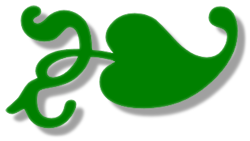Hedera
Gardeners might expect that they’re about to hear something interesting about ivy, as Hedera is its genus name (Hedera helix is the common English ivy, where helix refers to the spiraling growth of its stems). Ivy is closely involved, but I’m actually writing about punctuation.
Much of our standard punctuation is a relatively modern codification that followed the introduction of printing in the fifteenth century. Some is based on post-classical scribal marks, such as the full stop. The slash or virgule (/), which was used to mark brief pauses in reading, evolved into the comma in the sixteenth century (virgule is a nineteenth-century importation from the French word for a comma, but it derives from Latin virga for a rod). Exclamation and question marks, colons and semicolons didn’t appear until the seventeenth century.

Classical Latin writers didn’t have any of these and didn’t feel the lack, but then written texts were intended to be read aloud rather than silently. They did have the capitulum, or chapter marker, which turned into the symbol we now call a pilcrow. Romans indicated the ends of texts with an ivy leaf, which they naturally called a hedera. Why they chose ivy is unknown. It was a symbol of Bacchus, the Greek and Roman god of wine, but that hardly seems to fit; perhaps it was just common and easy to draw.
The mark was carried over into English printing but by then it had become an ornament, one of a group that became known as fleurons (from Old French floron, a flower). You may still sometimes come across the hedera as a graphic symbol for a section break or as a decorative marker at the beginning of a paragraph.
